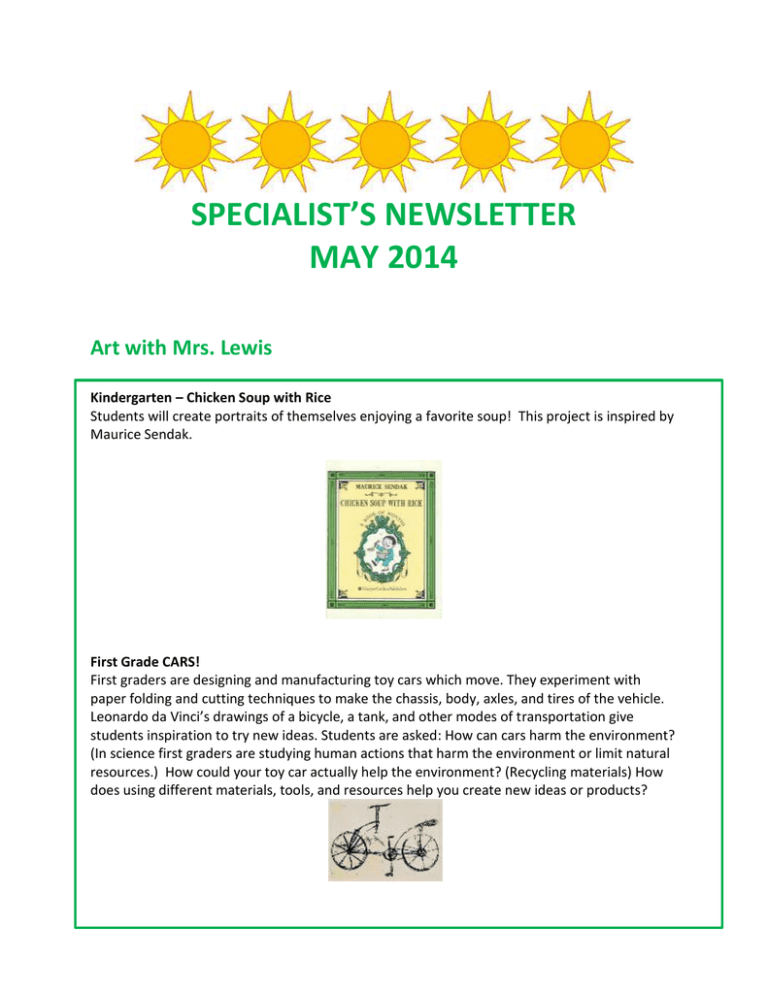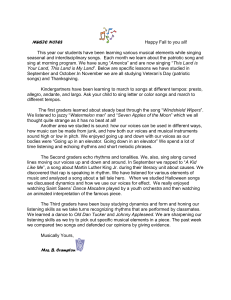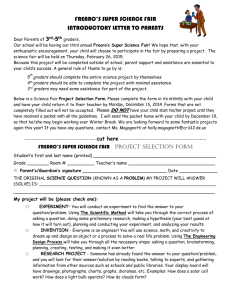SPECIALIST'S NEWSLETTER MAY 2014 Art with Mrs. Lewis
advertisement

SPECIALIST’S NEWSLETTER MAY 2014 Art with Mrs. Lewis Kindergarten – Chicken Soup with Rice Students will create portraits of themselves enjoying a favorite soup! This project is inspired by Maurice Sendak. First Grade CARS! First graders are designing and manufacturing toy cars which move. They experiment with paper folding and cutting techniques to make the chassis, body, axles, and tires of the vehicle. Leonardo da Vinci’s drawings of a bicycle, a tank, and other modes of transportation give students inspiration to try new ideas. Students are asked: How can cars harm the environment? (In science first graders are studying human actions that harm the environment or limit natural resources.) How could your toy car actually help the environment? (Recycling materials) How does using different materials, tools, and resources help you create new ideas or products? Second Grade–Sumie Paintings of Bamboo (continued from end of April) Second graders learn techniques of painting with a sumi-e brush and ink. They are challenged to carefully observe a bamboo still life. Students are asked: How can you represent a form with minimal strokes of a brush? Why could sumi-e painting be considered a spiritual experience? How did you feel when experimenting with this art form? Third Grade – Invasive Asian Carp Students are reading about this species in language arts. In art we are learning how to create a watery world with wet on wet watercolor techniques and how to fan fold pop up carp. Fourth Grade – Travelling Trunks (continued from end of April) Fourth graders study immigration in social studies. In art, we create miniature ceramic trunks. Students imagine a person sailing from Europe, through Ellis Island at the turn of the century. They sculpt and ‘pack’ the belongings this individual will need for survival; for remembering old world culture, family, and friends; for maintaining spiritual beliefs; and for adventure in the new world. Some questions students ask themselves: Why is my person leaving her homeland? What will her profession be in the new world? What items will be most valuable to her in the United States? Student’s work will be on display at the Ratner Museum on May 19! Fifth Grade (continued from end of April) We are creating ceramic tile for permanent installation on Somerset’s third floor. Instrumental Music with Ms. Crenwelge Instrumental music students are ready for their Spring Concert! The instrumental music students are playing for the school on Monday, May 19 th, so please make sure your child brings his/her instrument to school that day. They will be performing for parents on Wednesday, May 21st at 7 PM at Westland Middle School. Strings students should arrive at 6:15, and band students should arrive at 6:30. Strings and band students should arrive to rooms 128, 127B, and 127A (signs will be posted as to which ensemble will be in each room). Ms. Crenwelge looks forward to a great concert! Music with Mr. Hopkins In kindergarten, are continuing to work on musical opposites, such as long/short and high/low. The goal of these experiences is to prepare students to be introduced to rhythm (long/short) and melody (high/low) patterns in 1st grade. We are also experiencing composition by arranging pictures and icons to indicate sounds. Kindergarten music class will wrap up for the year with lots of time spend singing catchy songs that will help students to better match pitch and to expand their vocal range. We will also be playing a number of fun music games to get students thinking about music over the summer and to get them excited for 1st grade music! First graders are becoming experts on notating pitches on the three-lined staff. Towards the end of the year, we will have more changes to explore instrumental timbre (tone color) by identify and playing instruments from all over the world as well as explore their own vocal timbre by singing in and identifying different vocal registers. We will also explore composition through the arrangement of representative icons. Second graders will be choosing and playing classroom instruments and found sounds to enhance songs and musical stories. We will also be composing simple rhythm patterns and notating them using standard notation. Towards the end of the year, we will work on accurately matching pitch in different registers in our voice and expanding our range as to prepare ourselves for singing in harmony (multiple melodies sung simultaneously) in 3rd grade. Our third graders are working hard to prepare for our recorder concert on Tuesday, June 4. We are beginning to understand that learning an instrument, especially in a classroom setting, requires discipline and patience. Students are beginning to work as a team to self-regulate and monitor their own focus as well as their technique. It is exciting to see so many students to invested in producing a fine musical product and having a lot of fun along the way. We will be identify pitches Do, Re, Mi, Sol and La on the musical staff in preparation for our intensive study of solfege and sight-reading in the 4th grade. The fourth grade is continuing to work with solfege. We will the last two pitches, La and Ti and begin to label songs which use all seven pitches of the scale. We are in the process of labeling the pitches of the famous “Ode to Joy” so that we may play this iconic tune on classroom instruments. We are reviewing dynamics (volume) and tempo (speed) to that we will be able to intelligently and thoroughly compare and contrast two recordings of the same song. This task provides us the opportunity to combine all of the aural analytical skills we have learned thus far to holistically understand the musical choices that performers make. And of course, we will continue to work on our music reading skills. Students will have more opportunities to learn songs without assistance through the application of their knowledge of rhythm and solfege syllables. The fifth grade just finished a unit on texture or musical layers. We are also learning a bunch of fun songs from foreign cultures in order to teach ourselves about syncopation (rhythmic figures that stress the off-beats). PE with Mr. House May is the month of field day! Field Day is the culmination of many skills taught and learned in physical education classes. It’s the time when children get to showcase many of their favorite activities to their parents, teachers, and classmates. It is also the time to apply skills in a lively and fun atmosphere filled with both team and individual games and activities. May 13th – Grades 3-5 and May 14th – Grades 1 & 2. This year, and one of the concepts reviewed in May during physical education classes, students have been setting goals to achieve higher levels of “perceived exertion” based on utilizing a perceived exertion scale – a self monitoring tool that creates self-awareness for “how hard they are breathing.” The perceived exertion scale (located in the gym) also provides the information necessary to adjust one’s personal exercise level, and relates to the FITT principle (frequency, intensity, time, and type of exercise), which was discussed in April’s newsletter. Students draw conclusions about how the FITT principle is directly related to one’s own personal level of perceived exertion – not only during P.E. class, but in any activity - throughout field day, recess, and/or during before or after school or weekend activities. On field day students will have fun playing games and activities – that they know and love but with the improved understanding of one’s own level of perceived exertion, at any given time in their lives.

